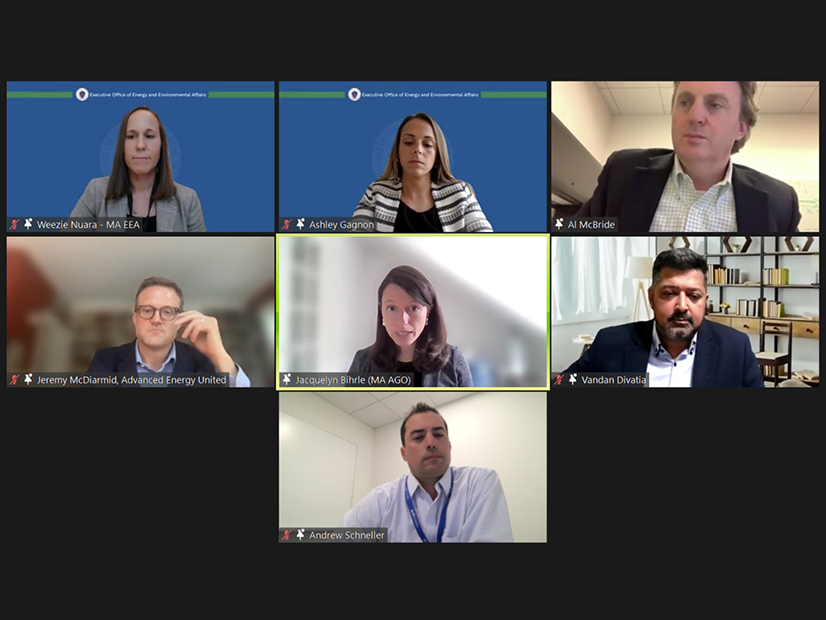
Unlocking the full potential of advanced transmission technologies (ATTs) will be essential to limiting transmission costs associated with the clean energy transition in Massachusetts, a panel of experts said at a forum July 17.
The “pop-up forum” was convened by the Massachusetts Executive Office of Federal and Regional Energy Affairs and coincided with the state legislature’s scramble to pass a climate bill before the end of the legislative session. If passed, the bill appears likely to include language requiring transmission and distribution owners to consider ATTs when proposing new infrastructure.
“You’re taking up the topic at a critical time,” said Sen. Mike Barrett (D), co-chair of the Joint Committee on Telecommunications, Utilities and Energy.
“Where do ATTs figure in?” Barrett asked the speakers in his opening remarks. “We really need to know if we’re talking about something with a major set of implications for New England, or a more marginal set.”
The terms ATTs and grid-enhancing technologies (GETs) refer to a range of technologies aimed at maximizing the capability of existing transmission infrastructure. These technologies can be used to address transmission constraints without requiring major new infrastructure.
“There’s potentially billions of dollars of value here,” said Lakshmi Alagappan of Energy and Environmental Economics (E3). Alagappan focused on five technologies that “exhibit strong potential” in the region: advanced conductors, dynamic line ratings, power flow controllers, storage-as-transmission-only assets and topology optimization.
While FERC Order 1920 requires transmission operators to consider GETs in long-term planning, “there is a much broader opportunity to look more holistically” at the role that ATTs can play, Alagappan said.
Alagappan emphasized the importance of creating standards for software compatibility, amending rules to allow new technologies to participate in transmission solicitations and ensuring that studies account for the full scope of potential ATT benefits.
“Proactively taking these steps now will be critical,” Alagappan said.
Representatives of Eversource Energy and National Grid, which own significant transmission assets in New England and electric distribution utilities in Massachusetts, said some of the technologies are already deployed in the region, but that more can be done to scale up their use.
“We’re not starting from zero, but we’re not at full capacity yet,” said Vandan Divatia of Eversource, adding that the company frequently considers adding advanced conductors when replacing structures for asset condition needs.
Andrew Schneller of National Grid said the consideration of advanced conductors has become “somewhat of a standard,” and noted that the company deployed DLR to achieve a 20 to 30% increase in the capacity of a line in Rhode Island.
Both Schneller and Divatia said tariff requirements for transmission owners to select the lowest-cost solution to isolated issues could be a barrier to deployment. ATT solutions may have a wider range of long-term benefits but still come in as the more expensive solution to the specific issue at hand, Schneller said.
Jacquelyn Bihrle of the Massachusetts Attorney General’s Office said it is “encouraging from our perspective that these technologies are being deployed where possible,” but she said that considering all possible ATT solutions to transmission needs should be “a routine, standardized part of the process.” While Order 1920 “sets a floor” by requiring the consideration of ATTs, “it must be more than a check-the-box exercise.”
Bihrle called for increased accountability and transparency regarding how TOs evaluate ATT solutions. She highlighted the idea of an independent transmission monitor as “one way to achieve that level of scrutiny” and help address the “information asymmetry” between TOs and consumers.
Al McBride of ISO-NE said there may be a role for the RTO to help “explain to people what the likely use cases are for the different technologies.”
He emphasized that ISO-NE solicitations are centered around selecting the lowest-cost solution, regardless of whether a solution is based on new technology or traditional infrastructure.
Separate climate bills recently passed by the Massachusetts House of Representatives and Senate include identical language requiring “due consideration” of ATTs for new transmission and distribution infrastructure.
Following the passage of the House bill on July 17, the bills now go to a conference committee, where legislators will try to quickly formulate a compromise bill to pass and send to Gov. Maura Healey (D) before the end of the legislative session July 31.


